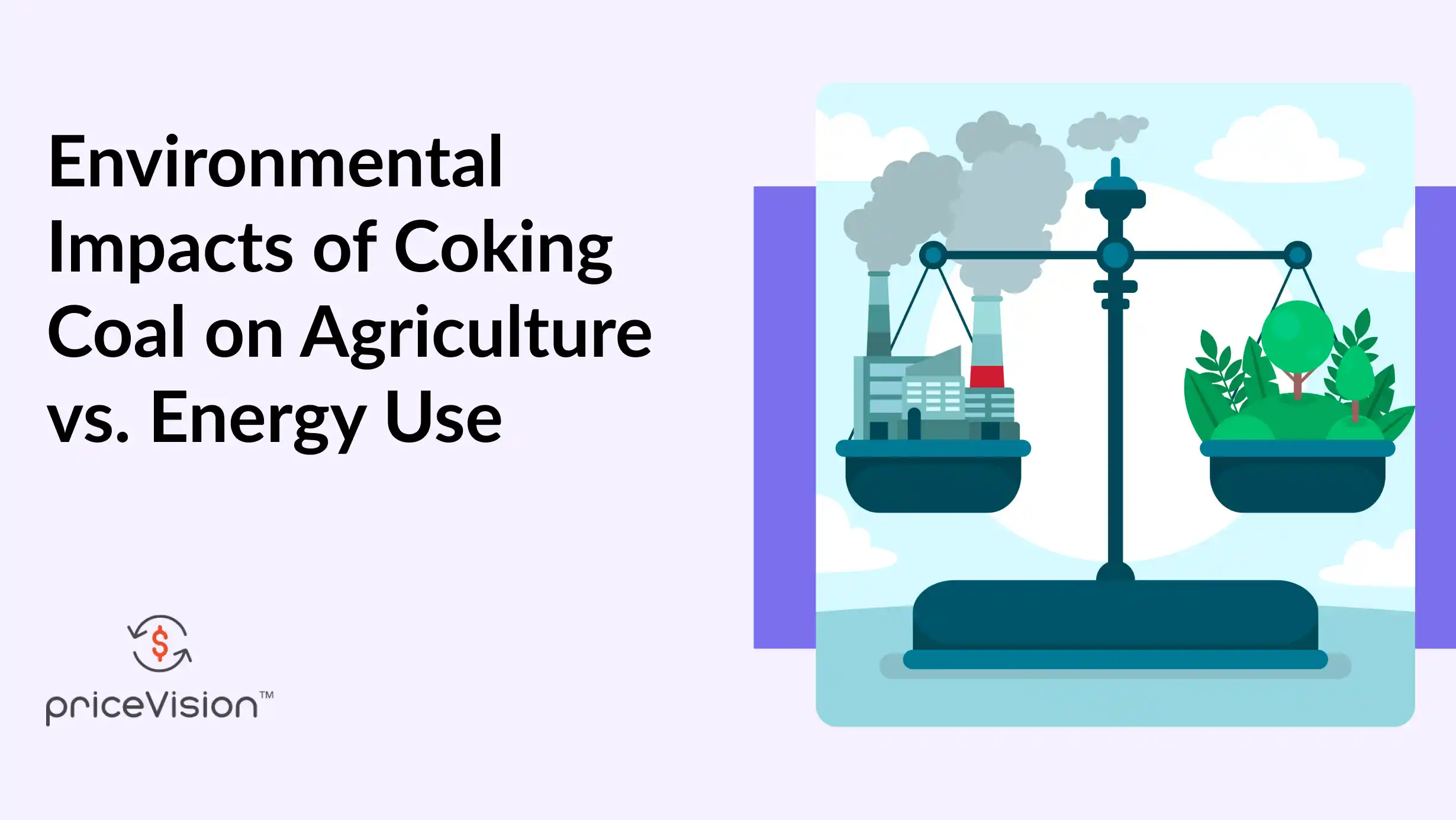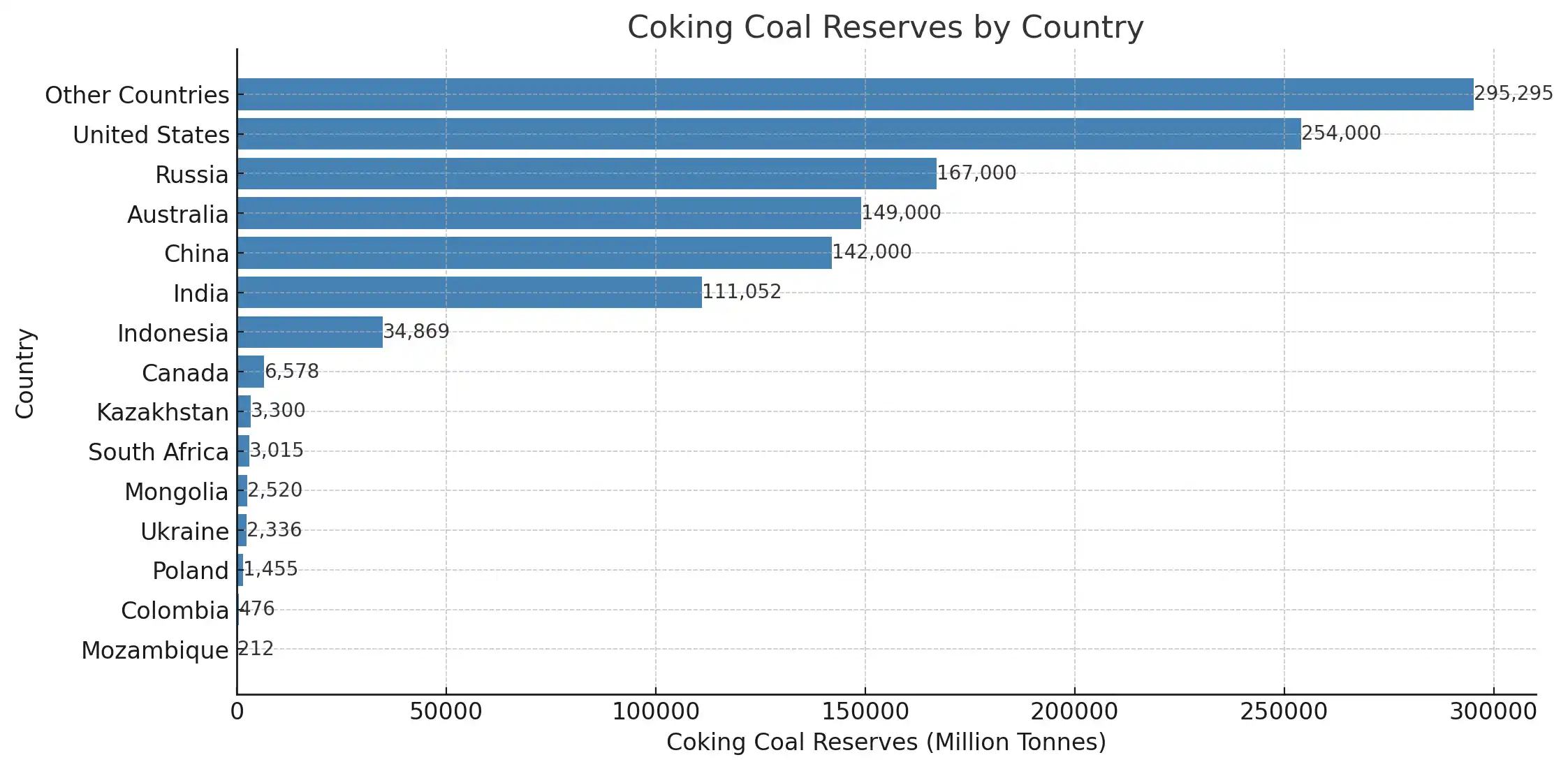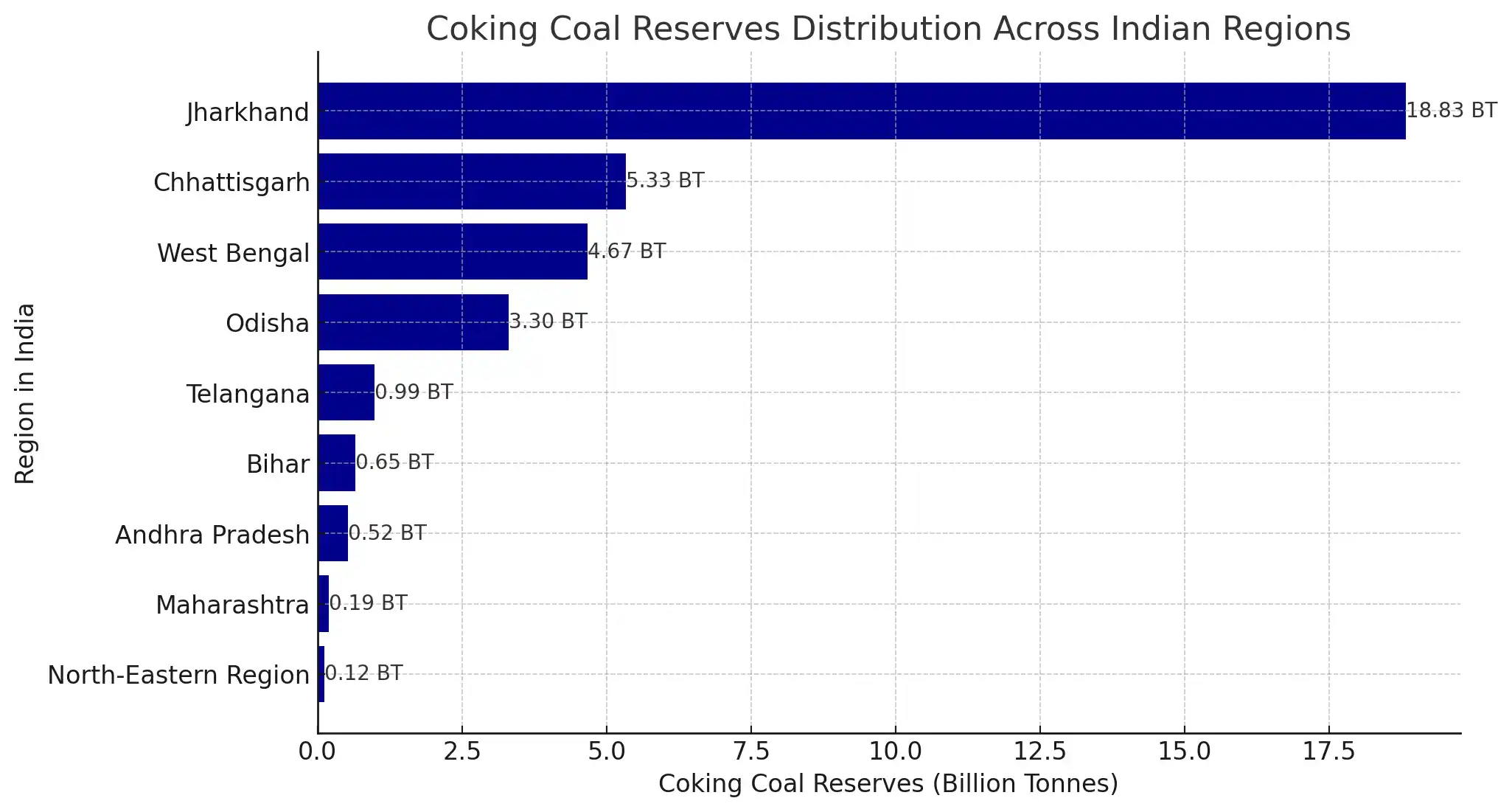Environmental Impacts of Coking Coal on Agriculture vs. Energy Use

Did you know that the same coal used for steel production is also raising major environmental concerns? In India, coking coal fuels an intense debate—balancing economic necessity with sustainability. Let’s dive into its impact on agriculture and energy. The way we mine and use coking coal can harm the environment in many ways, like polluting the air and water, ruining land, and adding greenhouse gases.
In India, where farming is super important and we're using more and more energy, using coking coal for both steel and energy is tough. Lots of India's power comes from coal, around 70%! This makes us wonder: is it worth it to keep using coal for power, or should we look for other options that are better for farming and the environment?
The Ministry of Coal in India says we're importing more and more coking coal every year. Last year, it was over 47 million tonnes! This shows how much we need it, but also that we need to think carefully about how it affects the environment, farming, and energy.
This blog is all about digging into the tricky balance between taking care of the environment, making sure farmers have what they need, and meeting our energy needs in India's coking coal industry. We'll look at the challenges we face and the chances we have to do things in a way that's good for everyone.
Understanding Coking Coal
Coking coal, also known as metallurgical coal, is a special type of coal that can be turned into coke, a vital fuel and agent used in making steel. When heated without air (carbonization) at very high temperatures above 1,000°C, coking coal gets soft, melts, and then becomes a hard, hole-filled substance called coke.
Coking coal usually has more carbon, less ash, and less moisture compared to thermal coal, which is used for making electricity. It's got more carbon and less sulfur, phosphorus, and alkalis.
Distinction Between Coking Coal and Thermal Coal


|
Characteristic |
Coking
Coal |
Thermal
Coal |
|
Main Use |
Essential for the production of steel, as it is converted
into coke, a crucial component in steelmaking processes. |
Primarily utilized in power generation, providing heat
energy through combustion. |
|
Carbon Content |
Contains a higher percentage of carbon, typically
ranging from 60% to 90%. |
Possesses a lower carbon content, typically ranging
from 45% to 85%. |
|
Ash and Moisture Levels |
Generally lower ash and moisture levels, reducing
impurities during combustion and refining processes. |
Typically higher ash and moisture content, which may result
in more waste during combustion and require additional purification
processes. |
|
Heating Value |
Higher heating value due to its higher carbon content,
providing more energy per unit mass. |
Lower heating value compared to coking coal, resulting
in lower energy output per unit mass. |
|
Impurities |
Reduced levels of sulfur, phosphorus, and alkalis,
contributing to cleaner combustion and fewer emissions. |
Often contains higher levels of sulfur, phosphorus, and
alkalis, which can lead to increased emissions and environmental concerns. |
|
Formation |
Formed through carbonization under high pressure and
temperature conditions over millions of years, resulting in a dense, hard
coal suitable for steelmaking. |
Formed through the natural decomposition of organic
matter over geological time periods, typically in layers or seams within
sedimentary rock formations. |
|
Global Reserves |
Limited global reserves compared to thermal coal, with
major producers including Australia, the United States, and Russia. |
Abundant global reserves, with major producers
including China, India, the United States, and Australia. |
Chemical Composition and Properties
Coking coal, also called metallurgical coal, is crucial for making steel because of what it's made of and how it acts. Let's take a closer look at its parts and what it can do.
What It's Made Of
Coking coal is mostly carbon, but it also has other elements mixed in. The main ones are:
● Carbon (C): This is the most common element in coking coal, making up about 60-90% of it. Carbon is important because it helps make coke, which is necessary for making steel.
● Hydrogen (H): Coking coal has a good amount of hydrogen, usually around 2-5%. Hydrogen helps with reducing iron oxides when making steel.
● Sulfur (S): There's not much sulfur in coking coal, usually less than 1%. Too much sulfur can cause air pollution and damage equipment.
● Nitrogen (N): Nitrogen is also kept low, usually less than 1%. Too much nitrogen can create harmful pollutants when the coal burns.
● Oxygen (O): Oxygen levels vary, but they're usually between 5-15%. Oxygen affects how the coal burns and the quality of the coke it makes.
● Ash: Ash is the minerals left over when the coal burns. It's better to have less ash because it means fewer impurities in the final coke.
Properties:
The makeup of coking coal gives it some important properties that make it good for steelmaking:
● Carbon Component: Coking coal has a high amount of carbon, which is needed to make coke. Coke is used to fuel and reduce iron in the blast furnace.
● Volatility: Coking coal doesn't give off too many volatile compounds when it's turned into coke. This helps make strong coke that doesn't react too much.
● Forms a Cake: Coking coal can stick together and form a solid mass when it's heated without melting. This helps make strong coke that holds up well.
● Reacts Well: Coking coal needs to react just right to make good coke in the blast furnace. How well it reacts depends on things like its carbon content, how "mature" it is, and what minerals it has.
● Low Sulfur and Phosphorus: It's best if coking coal doesn't have much sulfur or phosphorus. Too much can make the steel impure and harder to work with.
● Strong and Porous: The quality of coke made from coking coal depends on how strong and porous it is. Good coke needs to be strong enough to hold up in the furnace but also porous enough to let gases pass through and help reduce iron.
● Consistent and Even: It's important for coking coal to be consistent in its makeup and behavior. This helps make sure the coke it makes is always good quality and the steelmaking process runs smoothly.
Global Distribution of Coking Coal Reserves

● The table shows the estimated coking coal reserves in million tonnes for various countries around the world.
● The numbers represent the amount of coking coal each country is believed to have in its reserves.
● These reserves are essential for future coking coal production and are crucial for industries like steelmaking.
● The "Other Countries" category includes all other nations not individually listed in the table, with a combined reserve of 295,295 million tonnes.
● The total global coking coal reserves add up to approximately 1,074,108 million tonnes.
Sources: 1, 2,
Coking Coal Reserves in India
Coking coal, an essential ingredient for making steel, is crucial for India's industrial growth. Here, we'll explore India's coking coal reserves, where they're found, how they're mined, and the challenges involved.
India's Coking Coal Reserves:
India has substantial coal reserves, ranking fourth globally. But most of it isn't suitable for making steel. As of April 1, 2022, India had about 361.41 billion tonnes of coal reserves. Coking coal makes up a smaller part, which we divide into:
- Prime Coking Coal: Best for making steel directly. India has about 5.3 billion tonnes.
- Medium Coking Coal: Needs mixing with better coal for steelmaking. India has around 28.08 billion tonnes.
- Blendable/Semi-Coking Coal: This can be used after mixing with better coal. India has approximately 1.71 billion tonnes.
Where Coking Coal is Found in India: Geological Distribution
Over millions of years, coal formed in various parts of India. The main coking coal reserves are in the Gondwana Supergroup, an ancient sedimentary layer. We divide these into:
- Permian Gondwana Coal: Best quality, mainly found in the eastern and central regions like Jharia, Raniganj, and Bokaro coalfields.
- Tertiary Gondwana Coal: Lower quality, mostly in northeastern areas like Assam and Arunachal Pradesh.
Let's see how the coking coal reserves are spread out across these regions:


Consumption Patterns and Demand Drivers
India's steel industry is growing, both at home and abroad, which affects how much coking coal the country uses. This section looks at how much coking coal India uses and what drives that demand.
How Much Coal Does India Use?
● India's steel production is on the rise, and so is its use of coking coal.
● Coal India's production for April to January for FY 2023-24 was 610.3mt.
● Most of the coking coal India uses stays within the country to feed its steel mills.
● A small amount is exported to nearby countries like Nepal and Bhutan.
Environmental Concerns in Indian Coking Coal Mining
Coking coal, a vital resource for steel production, comes at a significant environmental cost in India. The process of extracting this valuable resource raises serious concerns about land degradation, water pollution, air quality, and climate change. Striking a balance between industrial development and environmental protection is a critical challenge for India's coal mining industry.
1) Impact on Land: Deforestation, Land Degradation, and Loss of Biodiversity
The initial stages of coking coal mining inflict significant damage on the land:
● Deforestation: Establishing opencast mines often necessitates clearing large swathes of forests. This not only destroys valuable ecosystems but also disrupts habitats for diverse flora and fauna. A study by the Centre for Science and Environment (CSE) in 2019 reported that between 1990 and 2016, India lost over 1.3 lakh hectares of forest cover due to coal mining activities.
● Land Degradation: Mining activities physically alter the landscape. Topsoil removal, overburden dumping, and subsidence (the sinking of land) create barren wastelands unsuitable for agriculture or natural vegetation growth. As of January 12, 2024, the Indian government found 299 mines that are no longer in use, and Coal India Ltd is working to close them. The Indian Bureau of Mines (IBM) found 297 of these mines to be abandoned, with 82 needing to be fixed up and restored.
● Loss of Biodiversity: Habitat loss due to deforestation and land degradation disrupts the delicate balance of ecosystems. This leads to a decline in plant and animal species diversity, impacting the entire food chain. A 2018 research paper published in the journal "Current Science" found that coal mining activities in Jharkhand significantly reduced species diversity, with a decline of up to 50% in plant and animal species compared to undisturbed areas.
2) Water Pollution and Scarcity: Effects on Local Communities and Ecosystems
● Polluted Waterways: Mining activities often pollute nearby rivers and streams. Acid mine drainage, a toxic cocktail of sulfuric acid and heavy metals, contaminates water bodies, rendering them unfit for drinking, irrigation, and aquatic life.
● Water Scarcity: Large volumes of water are used for dust suppression, processing coal, and other mining operations. This can deplete groundwater reserves, affecting water availability for local communities and agricultural activities. Additionally, the altered drainage patterns caused by mining can disrupt natural water recharge processes, worsening water scarcity in the long run.
● Aquatic Life Suffers: The polluted water disrupts aquatic ecosystems, impacting fish populations and other aquatic organisms. This can disrupt local food chains and affect the livelihoods of communities dependent on fishing.
3) Air Pollution from Mining Operations: Respiratory Health Risks and Environmental Degradation
● Dust Devils: Blasting, transportation of coal, and exposed surfaces in opencast mines generate enormous amounts of dust. This air pollution irritates the lungs, increases the risk of respiratory illnesses like asthma, and can cause other health problems.
● Greenhouse Gas Emissions: Coal mines are significant sources of methane, a potent greenhouse gas contributing to global warming. Additionally, the blasting and transportation activities release harmful pollutants like nitrogen oxides and sulfur oxides, further deteriorating air quality.
● Smog and Acid Rain: These air pollutants can lead to the formation of smog, reducing visibility and causing respiratory distress. Furthermore, the reaction of these pollutants with atmospheric moisture can lead to acid rain, damaging vegetation, buildings, and aquatic ecosystems.
4) Climate Change Implications: India's Contribution to Carbon Emissions and Global Warming
● Coal and Carbon: Coking coal, when used in steel production, ultimately leads to the release of significant carbon dioxide emissions. This contributes to global warming and climate change, impacting weather patterns, sea levels, and extreme weather events.
● India's Role: As a rising industrial power, India relies heavily on coal, making it a significant contributor to global carbon emissions. This dependence on a fossil fuel with high environmental costs poses a challenge for India's commitment to sustainable development and its fight against climate change.
Agricultural Impact and Land Use Conflicts
The competition for land between mining and agriculture is a big deal in India. With the country's fast economic growth, there's more demand for resources like coal and minerals. This means more mining, which often clashes with farming. India has abundant of coal, iron ore, and other minerals crucial for industry. But as mining grows, it takes up farmland, leading to clashes between mining firms and farmers.
For example, India's coal mining has boomed as the government aims to produce more coal for power. But this means taking over lots of farmland, causing conflicts. According to the National Green Tribunal, coal mining has taken over 100,000 hectares of farmland, displacing many farmers.
1) Soil Damage and Less Fertility: Bad News for Farmers
Soil damage and less fertility are big issues in India, especially in farming. Damage happens from activities like cutting down trees, overgrazing, and intense farming. The National Bureau of Soil Survey says over 30% of India's soil is damaged. This hurts farmers because damaged soil means fewer crops and less productivity.
Soil losing its fertility is also a big issue, especially with intense farming. The International Fund for Agricultural Development says using chemicals in farming has damaged soil, leading to less crops and productivity.
2) Water Shortages and Farming Woes: Irrigation and Water Problems
India has a big problem with not enough water, especially for farming. The fast-growing population and industries need more water, leaving less for farming. The Ministry of Water Resources says over 60% of water goes to farming, causing big shortages.
Irrigation and water problems are a big deal for farming in India. The World Bank says poor irrigation systems waste lots of water, leading to less crops and less food.
Farming issues in India, like land competition, soil damage, and water shortages, need fixing fast for farming to be sustainable.
Energy Use and Steel Production in India
Steel is crucial for India's infrastructure growth, and vital for the country's economy. It's the backbone of projects like roads, bridges, railways, airports, and ports. Steel's durability, strength, and versatility make it perfect for building strong and long-lasting infrastructure that can handle heavy loads, earthquakes, and tough weather conditions.
Various sectors, including construction, automotive, and manufacturing, drive India's infrastructure growth. Construction heavily relies on steel for homes, offices, and factories. Steel's flexibility, efficiency, and eco-friendliness make it a top choice for builders creating modern, innovative structures to meet urbanization and population growth demands.
Innovations in Saving Energy: Chances and Hurdles
Finding ways to save energy is key to making steel production more eco-friendly. India's steel industry is trying out new technologies like better blast furnaces, continuous casting, and electric arc furnaces to use energy more efficiently. Using these technologies has helped cut down on how much energy the steel industry uses. But even with these improvements, the steel industry still faces big challenges in using less energy. It needs more research, development, and new technologies to use less energy while still making lots of steel.
Energy and steel production in India go hand in hand. Steel is crucial for building infrastructure, and coking coal is crucial for making steel. Finding ways to use less energy is crucial for making the steel industry more sustainable.
Conclusion
Coking coal, crucial for making steel, is a big deal in India's growth story. But its use brings up serious environmental worries. From harming land to polluting water and air, the impact of mining coking coal is huge.
Even though we need coking coal to keep up with steel demand and boost our economy, we must find a balance with the environment. The way things are going now, we risk damaging ecosystems, hurting local communities, and harming our planet.
Moving forward, we need everyone involved to work together. We need rules that make sure mining is greener and fairer. We also need new technologies to use energy smarter and make mining more sustainable.
But it's not just about rules and tech. We also need to listen to communities and make sure everyone benefits from coking coal mining. By working together and thinking long-term, we can create a future where growth goes hand in hand with taking care of our environment.